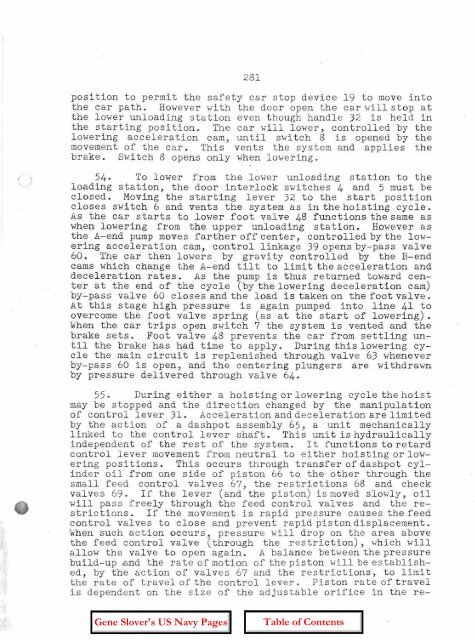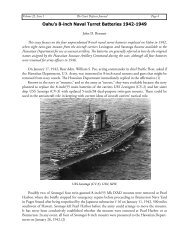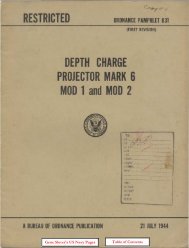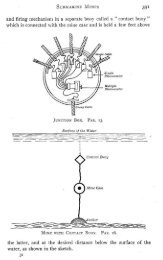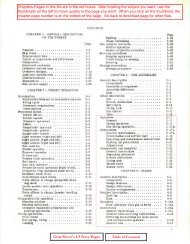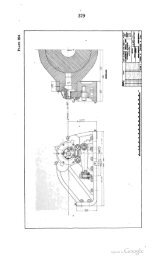OP-755 Part 2 Pages 197-401 - Personal Page of GENE SLOVER
OP-755 Part 2 Pages 197-401 - Personal Page of GENE SLOVER
OP-755 Part 2 Pages 197-401 - Personal Page of GENE SLOVER
You also want an ePaper? Increase the reach of your titles
YUMPU automatically turns print PDFs into web optimized ePapers that Google loves.
,<br />
281<br />
position to permit the safety car stop device 19 to move into<br />
the car path. However with the door open the car will stop at<br />
the lower unloading station even though handle 32 is held in<br />
the starting position. The car will lower, controlled by the<br />
lowering acceleration cam, until switch 8 is opened by the<br />
movement <strong>of</strong> the car. This vents the system and applies the<br />
brake. Switch 8 opens only when lowering.<br />
54. To lower from the lower unloading station to the<br />
loading station, the door interlockswi tches 4 and 5 must be<br />
closed. Moving the starting lever .32 to the start position<br />
closes switch 6 and vents the system as in the hoisting cycle.<br />
As the car starts to lower foot valve 48 functions the same as<br />
when lowering from the upper unloading station. However as<br />
the A-end pumpmoves farther <strong>of</strong>f center, controlled by the lowering<br />
acceleration cam, control linkage .39opens by-pass valve<br />
60. The car then lowers by gravity controlled by the B-end<br />
cams which change the A-end tilt to limit the acceleration and<br />
deceleration rates. As the pump is thus returned toward center<br />
at the end <strong>of</strong> the cycle (by the lowering deceleration cam)<br />
by-pass valve 60 closes and the load is taken on the foot valve.<br />
At this stage high pressure is again pumped into line 41 to<br />
over~ome th~ foot valve spring (as at the start <strong>of</strong> lowering).<br />
Whenthe car trips open switch 7 the system is vented and the<br />
brake sets. Foot valve 48 prevents the car 'from settling until<br />
the brake has had time to apply. During this lowering cycle<br />
the main circuit is replenished through valve 6.3 whenever<br />
by-pass 60 is open, and the centering plungers are withdrawn<br />
by pressure delivered through valve 64.<br />
55. During either a hoisting or lowering cycle the hoist<br />
may be stopped and the direction Changed by the manipulation<br />
<strong>of</strong> control lever.31. Acceleration and deceleration are limited<br />
by the action <strong>of</strong> a dashpot assembly 65, a unit mechanically<br />
linked to the control lever shaft. This unit is hydraulically<br />
independent <strong>of</strong> the rest <strong>of</strong> the system. It functions to retard<br />
control lever movement from neutral to either hoisting or lowering<br />
positions. This occurs through transfer <strong>of</strong> dashpot cylinder<br />
oil from one side <strong>of</strong> piston 66 to the' other through the<br />
small feed control valves 67, the restrictions 68 and check<br />
valves 69. If the lever (and the piston) is moved slowly, oil<br />
will pass freely through the feed control valves and the restrictions.<br />
If the movement is rapid pressure causes the feed<br />
control valves to close and prevent rapid piston displacement.<br />
When such action occurs, pressure will drop on the area above<br />
the feed control valve (through the res triction), which will<br />
allow the valve to open again. A balance between the pressure<br />
build-up and the rate <strong>of</strong> motion <strong>of</strong> the piston will be established,<br />
by the action <strong>of</strong> valves 67 and the restrictions, to limit<br />
the rate <strong>of</strong> travel <strong>of</strong> the control lever. Piston rate <strong>of</strong> travel<br />
is dependent on the size bf the adjustable orifice in the re-


